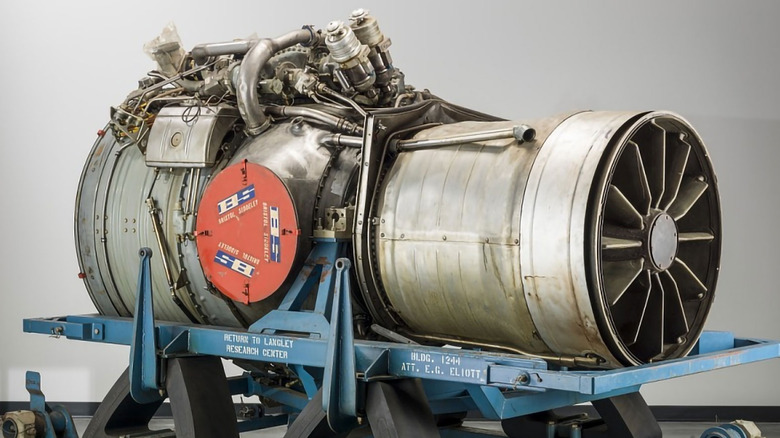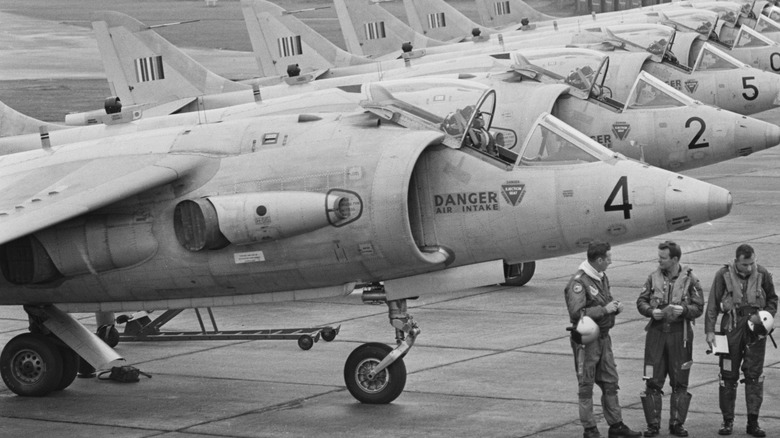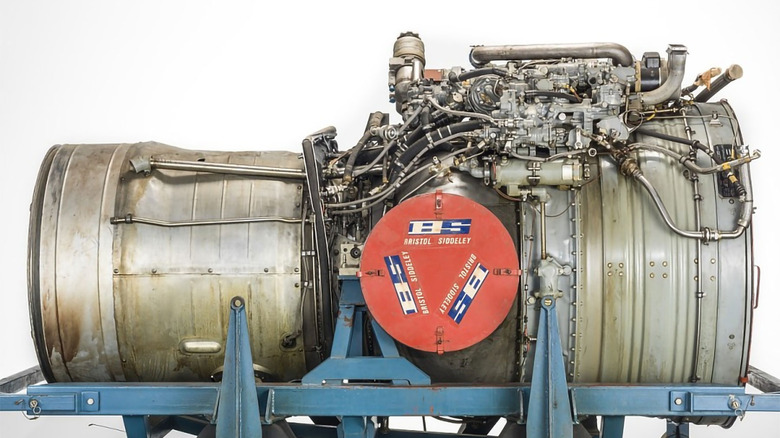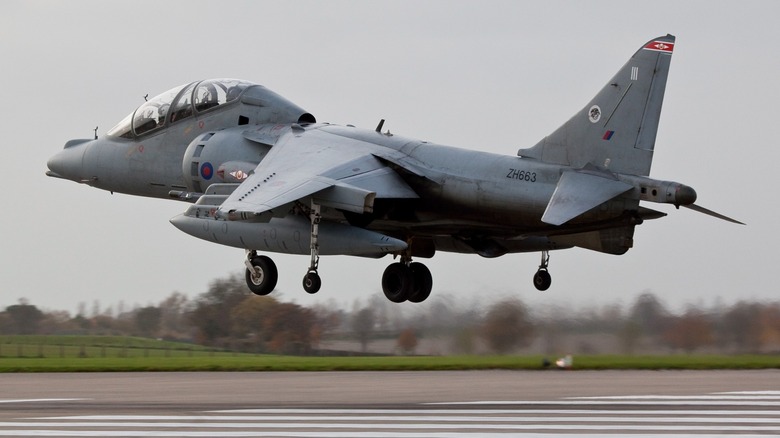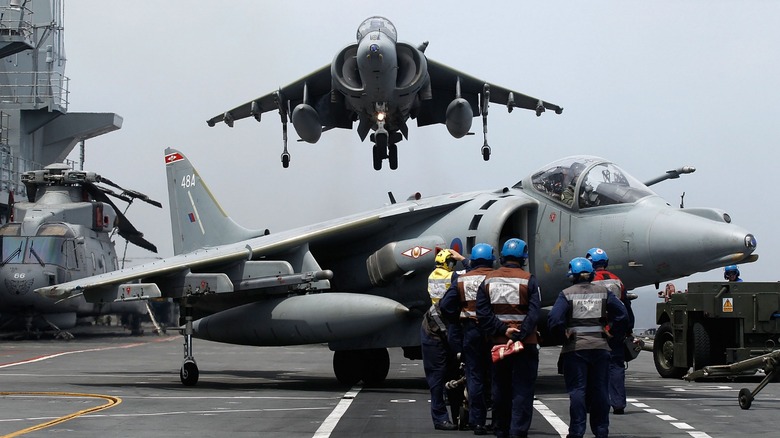Rolls-Royce Pegasus: Behind The Creation Of The Massive Jet Engine
Though Rolls-Royce may be most well-known for its line of luxury vehicles, you may be surprised to learn that it also produced some of the earliest advanced attack jet engines. The Harrier jet is an iconic military attack jet most known for its ability to take off and land vertically. The Rolls-Royce Pegasus is the turbofan engine that powers it, enabling the Harrier to pull off unique combat maneuvers that other jets can't.
Used by both the Royal Air Force (RAF) and the United States Marine Corps (USMC) for decades, the Rolls-Royce Pegasus was an innovative engineering marvel that powered the aircraft's unique aerodynamic abilities. What also may surprise you is that the concept of the massive jet engine started its journey all the way back in the 1950s, right after the end of WWII.
While stranger vertical thrust aircraft would also be conceived in the 50s and 60s, like the ill-fated and peculiar Convair Model 49, ultimately, the RAF's Harrier Jet and USMC's AV-8 jets would be the most effective designs capable of using the vectored thrust engines.
The birth of the Rolls-Royce Pegasus started in the 1950s
In the early 1950s, after World War II, the North Atlantic Treaty Organization (NATO) set out to address the potential vulnerability of the Allied Forces' airfields. This would lead the powers to develop what was known as the Mutual Weapons Development Program (MWDP). This initiative sought to develop a lightweight engine to power an advanced fighter jet capable of taking off and landing with limited runway space, or, as it would be later designated, VSTOL (vertical/short takeoff and landing).
The earliest engine capable of vertical takeoff took place as early as 1954, with the Rolls-Royce Thrust Measurement Rig, better known as the Flying Bedstead. However, that aircraft was incredibly light relative to a fighter jet, was not a military attack aircraft, and lacked horizontal propulsion.
The first iteration of a useable VSTOL jet engine was dubbed the Bristol BE25 Orion, developed in 1956 by the French aircraft designer Michel Wibault and only had around 8,000 horsepower. These initial designs would be sent by the MWDP in Paris to Dr. Stanley Hooker at The Bristol Aeorplane Company in the U.K., which initially manufactured the first few prototypes of what would eventually go on to be the Pegasus.
The Rolls-Royce Pegasus underwent years of development and improvement
Dr. Hooker worked with Gordon Lewis at Bristol and Michel Wibault to enhance the engines in a few ways. They proposed a lighter and more simplistic design consisting of a two-stage axial flow fan and rotating, swiveling nozzles on the side of the aircraft, which would enable the vectored thrust to meet the requirements put forth by NATO. However, the engine still required a lot of research and development before it would enter full production for a specific aircraft.
The Bristol BE25 Orion was just the start of what would be a series of new engine designs, each improving upon the last iteration. In the autumn of 1957, the prototype would officially be renamed Pegasus and was aimed to be fitted in a Hawker Siddeley XV-6 Kestrel, or P.1127, one of the first jets capable of vertical takeoff and landing, and one designed specifically to accommodate the Pegasus.
In October of 1960, initial tests of the new Pegasus 5 engine inside a P.1127 took place, with its first untethered flight occurring one month later. Eventually, Bristol Aeorplane Company would be absorbed by Bristol Siddeley Engines, which was then acquired by Rolls-Royce in 1966 for £63.6 million.
The Mk101 was the first standard production Pegasus
1969 would mark the first year that prototyping and development for the Pegasus would finally be complete, with the full production of the Pegasus Mk101 for the Hawker Siddeley Harrier. This new engine was capable of a thrust of 19,000 pounds and was quickly upgraded to the Mk102 and Mk103, further improving upon previous models.
With the creation of the Mk103, the Pegasus' thrust would be raised to 21,000 pounds to accommodate the RAF's Harrier jets and USMC's AV-8A. In the same year, Great Britain would form its first squadron of Harrier fighter jets, followed by the USMC a few years later in 1971.
Around this time, a powerful flight technique called Vector In Forward Flight (VIFF) was discovered, which enabled pilots of the AV-8A and Harrier to vastly increase their maneuverability by rotating the nozzles of the Pegasus downward in normal flight. This enabled the plane to perform maneuvers that other jets were incapable of and later proved to be an effective combat tactic.
The future of the Rolls-Royce Pegasus
Eventually, along with the Harrier aircraft itself, the Pegasus would see a series of improvements and upgrades over the decades, with the latest Pegasus 11-61 serving as the engine for the Harrier II+ with the USMC, though the plane and engine are no longer in production.
The RAF also withdrew the Harrier II from service in 2010, along with the Pegasus engine. Though no longer in production for American armed forces, the AV-8B Harrier II attack planes will continue to stay operational with the USMC until 2029, with Rolls-Royce providing support even though the engines are no longer manufactured. Harriers will largely be replaced by the new, controversial F-35 stealth fighter jets, which utilize Pratt & Whitney F135 Engines.
Though it's amazing to think about, this will mean that some variation of the Pegasus engine will be used in operations for over 50 years before the United States finally retires the engine from use in 2029. This amazing fact can be chalked up to the amazing innovation and effectiveness of both the Pegasus engine and Harrier Jet.
